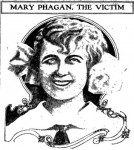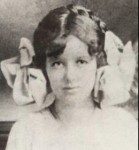 Mary Phagan, via Metapedia:
Mary Phagan, via Metapedia:
Mary Phagan was born in Florence, Alabama, in 1899, to John and Frances (Fannie) Phagan. She was born four months after her father John Phagan died, into a family that had farmed in Georgia for generations. Frances Phagan eventually re-married to a man named John William Coleman. They lived briefly in Alabama before moving back to Marietta, Georgia.
Phagan’s mother opened a boarding house, and her children took jobs in the local mills. Mary Phagan left school at ten to work part-time in a textile mill. She was hired in 1911 by a paper manufacturer. In 1912 her mother remarried, and she and the children moved to a poor neighborhood in the city of Atlanta.
Phagan took a job with the National Pencil Company in the Spring of 1912, where she ran a knurling machine that inserted rubber erasers into the brass bands at the end tip of pencils.
[Knurling is a manufacturing process whereby a diamond-shaped (criss-cross) pattern is cut or rolled into metal]
Mary Phagan, had been laid off the previous Monday, April 21, 1913, as a result of a shortage of brass sheet metal supplies. Phagan worked on the same floor as Leo Frank, which was the second floor of the National Pencil Company, though Phagan worked in a different area. Phagan labored in a section of the metal room known as the the tipping department.
Most of the child laborers, like Phagan, worked 11 hour shifts, 5 to 6 days a week, in horrendous conditions and for just pennies an hour.
Leo Frank, via Wikipedia:
Frank was born in Cuero, Texas, to Rudolph and Rachel Jacobs Frank. The family moved to Brooklyn, New York, in 1884, when Frank was three months old. He attended New York City public schools and graduated from Pratt Institute in 1902. He then attended Cornell University, where he studied mechanical engineering. After graduation in 1906, Frank worked briefly as a draftsman and as a testing engineer, before accepting a position with a firm owned by a relative.
At the invitation of his uncle, Frank traveled to Atlanta for two weeks in late October 1907 to interview for a position with the National Pencil Company, a manufacturing plant in which the uncle was a major shareholder. Frank accepted the position, and traveled to Germany to study pencil manufacturing at Eberhard Faber in Bavaria. After a nine-month apprenticeship, Frank returned to the United States and began working at the National Pencil Company in August 1908.[7] Leo Frank became superintendent of the factory in September 1908.
Frank was introduced to Lucille Selig shortly after he arrived in Atlanta. She came from a prominent and upper middle class Jewish family of industrialists who two generations earlier had founded the first synagogue in Atlanta.[8] Though she was very different from Frank, and laughed at the idea of speaking Yiddish, they were married in November 1910, at the Selig residence in Atlanta.[9]
Frank was elected president of the Atlanta chapter of the B’nai B’rith, a Jewish fraternal organization, in 1912.[10] The Jewish community in Atlanta was the largest in the South, and the Franks moved in a cultured and philanthropic milieu whose leisure pursuits included opera and bridge.
At the time of Mary Phagan’s murder, he was twenty-nine years old and had supervised the factory for almost five years.
The thesis of An American lynching: the Leo Max Frank Affair, mentioned in Part 1, is echoed in The Jew Accused: Three Anti-Semitic Affairs (Dreyfus, Beilis, Frank) 1894-1915, by Albert S. Lindemann. From the description at Amazon:
Three Jews–Alfred Dreyfus, Mendel Beilis, and Leo Frank–were charged with heinous crimes in the generation before World War I–Dreyfus of treason in France, Beilis of ritual murder in Russia, and Frank of the murder of a young girl in the United States. The affairs that developed out of their trials pulled hundreds of thousands of people into passionate confrontation.
This study explores the nature of modern anti-Semitism and the ways that politicians in the generation before World War I attempted to use hatred of Jews as a political device to mobilize the masses. The anti-Semitism surrounding the affairs is presented as an elusive intermingling of real conflict between Jews and non-Jews, on the one hand, and, on the other, fantasies about Jews derived from powerful myths deeply rooted in Western civilization.
Jews are the ones constructing and propagating myths. Thus any skeptical examination and debunking of jewish myth-making in the case of Frank serves to discredit the broader, longer-term myth-making they themselves link it to.
David Turner links Honoring Leo Frank; Story of Jew’s lynching gets new attention at History News Network, dated 8-14-05:
“I believe remembering something even though it is evil assures that it is never perpetuated again,” said Rabbi Steve Lebow, spiritual leader of Temple Kol Emeth in east Cobb, who identified the site a decade ago.
In 1995, he placed a plaque on a corner of a brick office building on the property. It reads: “Wrongly accused. Falsely convicted. Wantonly murdered.”
The jews want what they regard as evil to be remembered, to be regarded as evil by everyone. To do this they’re willing to “remember” a narrative that turns reality on its head. In the case of Leo Frank, this means inverting the facts – that Frank was accused for good reason, treated to a fair and exhaustive trial, sentenced to death and punished. Justice was served despite the collective efforts of jews to thwart it.
The 1913 Leo Frank Case and Trial Research Library, AKA leofrank.org, contains a trove of information countering the jewish narrative. From their page, Mary Phagan: Mary Phagan Kean (b. June 5, 1954), Namesake and Grand Niece of little Mary Phagan (1899 to 1913):
Almost exclusively over the last 100 years, the books romanticizing Leo Frank as a tragic martyr of Gentile culture have been written by Jews, this web site intends to put an end to this Jewish hoax, by letting everyone know what really happened. This Leo Frank research library is doing something no one else has ever dared to do, for the first time since the dramatic finale of the Leo Frank case on August 17, 1915, we are making the elusive 1,800 page official Georgia Supreme Court Case documents on Leo Frank, free to the public. This massive legal file had once been locked away in the vault of the Georgia State Archive since 1913, but now is available for the public to read in unaltered high resolution images.
When modern independent scholars look back on 100 years of the written and cinematic history concerning the Leo Frank case, through the metaphor of “an eagle flying above in the heavens, seeing the whole of the forest, and not just the individual trees”, and compare it against the dry leaves of the official trial and appeals records (1913 to 1915), it reveals a very ugly, malicious and hidden side of the Jewish community, one most Gentiles were not fully aware exists interwoven in the DNA of Jews, unless one studies the cycles and patterns of Jewish history and social culture. The Leo Frank Case is the doorway to understand the disfigured collective consciousness of American Ashkenazi Jewry.
The Southerner Perspective: Two Faces of One Case
On one side, the defense side of the case, the Leo Frank case evolved into an anti-Gentile Blood Libel and anti-Southern cause celeb for the Jewish community (nationally and internationally), and on the other side, Southerners became incensed with the relentless Jewish media defamation war waged against them and the unrelenting efforts to build national support for emotionally exonerating Leo Frank in the American heart, this is despite vindication of the Georgia Courts by the United States Supreme Court.
A good timeline of events is provided at Leo Frank Page, and has been fleshed out at leofrank.org’s Chronology of Events in the Leo Max Frank Epic Saga.
The details of the case, even just the timeline, are overwhelming.
In just the first two days of the timeline we find evidence contradicting the jewish narrative that Frank was “wrongly convicted” and “wantonly murdered”. Frank not the first suspect. Four other men were arrested in the two days after the murder, and the societal revulsion and reflex to lynch the suspect in such a heinous crime was evident even before Frank became a suspect:
police had to disperse a white mob threatening to lynch Newt Lee, the night watchman who had discovered Phagan’s body and was also under suspicion.
The overwhelming nature of the murder, trial, and evidence against Frank is also reflected in Arguments of Hugh M. Dorsey in the Leo Frank Murder Trial at Internet Archive, originally publish in April 1914. After 29 days of trial the prosecutor took the better part of 3 more days to make his 9+ hour closing argument. Printed it amounts to 158 pages.
The podcast will be broadcast and available for download on Tuesday at 9PM ET.
Podcast: Play in new window | Download










